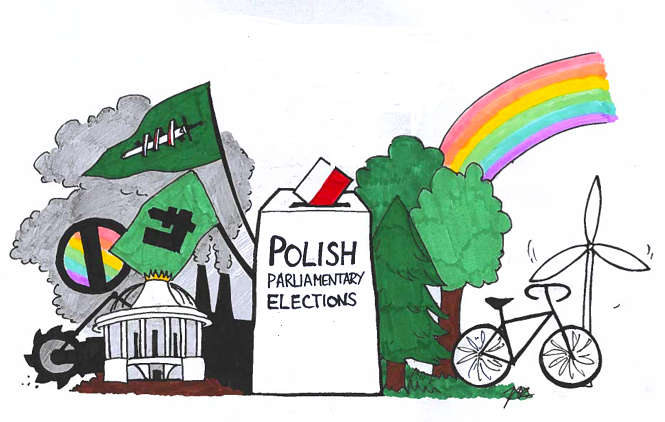The Polish General Election was held on Sunday 15 Oct 2023, as per the terms of the Polish Consitution. All seats in both the 460 seat lower house (Sejm) and 100 seat upper house (Senate) were voted for.
The process of election for the 460 seat Sejm is through party-list proportional representation via the D'Hondt method in multi-seat constituencies, with a 5% threshold for single party (KW) and citizen committees (KWW) and an 8% threshold for coalitions (KKW). National minority communities, such as the German minority, are waived from the requirement of accomplishing a nation-wide 5% result, and only need to do so in their electoral constituency, in this specific case Opole.
Senators are elected by first-past-the-post method in 100 constituencies. Most of the opposition (Civic Coalition, New Left and Third Way) signed a so-called senate pact, under which the parties agreed to enter one commonly accepted candidate in each district.This strategy has previously granted them 51 seats despite losing the Sejm in order to achieve.
The Polish system is completely alien to the UK system in that parties don't stand as parties as such and instead stand as groups of parties. Basically the eventual winners are a Coalition of Coalitions and nobody who voted gets what they voted for whatsoever. You might vote for a party, see it win seats and within weeks either cease to exist and become part of another party, switch from one group to another etc etc. It's also not unusual to find left wing parties allied to right wing groupings etc etc as regional interests and personalities play a major part, often way above particular left-right ideaologies. Independents can be aligned within a group, or can be independent independents. Confused yet? Then, after the results the various groups then try to ally with other groups - or even get individual parties to switch from other groups to theirs in order to try and cobble together some form of patch-work quilt Coalition government. It's basically a 'dog's dinner' and goes down hill from there as the trading begins. The joys of PR.
The results in the all important Sejm saw the ruling 'United Right' grouping fronted by the 'Truth and Justice' party lose their majority although they remain the largest single group, while the opposition groupings - with the largest being Civic Coalition led by Donald Tusk, achieved 54% combined, but not all of those would prefer working with Tusk as opposed to Kaczyński. Some will switch groups should the group they are in decide to ally with the wrong one out of Tusk/Kaczyński. Surprisingly the turn-out was a very healthy 74.4% so one can only assume the Poles find this chaos amusing.
At the time of writing, a new government has yet to be formed. Under Polish law, if a government cannot be formed within 30 days a fresh election is called.
The process of election for the 460 seat Sejm is through party-list proportional representation via the D'Hondt method in multi-seat constituencies, with a 5% threshold for single party (KW) and citizen committees (KWW) and an 8% threshold for coalitions (KKW). National minority communities, such as the German minority, are waived from the requirement of accomplishing a nation-wide 5% result, and only need to do so in their electoral constituency, in this specific case Opole.
Senators are elected by first-past-the-post method in 100 constituencies. Most of the opposition (Civic Coalition, New Left and Third Way) signed a so-called senate pact, under which the parties agreed to enter one commonly accepted candidate in each district.This strategy has previously granted them 51 seats despite losing the Sejm in order to achieve.
The Polish system is completely alien to the UK system in that parties don't stand as parties as such and instead stand as groups of parties. Basically the eventual winners are a Coalition of Coalitions and nobody who voted gets what they voted for whatsoever. You might vote for a party, see it win seats and within weeks either cease to exist and become part of another party, switch from one group to another etc etc. It's also not unusual to find left wing parties allied to right wing groupings etc etc as regional interests and personalities play a major part, often way above particular left-right ideaologies. Independents can be aligned within a group, or can be independent independents. Confused yet? Then, after the results the various groups then try to ally with other groups - or even get individual parties to switch from other groups to theirs in order to try and cobble together some form of patch-work quilt Coalition government. It's basically a 'dog's dinner' and goes down hill from there as the trading begins. The joys of PR.
The results in the all important Sejm saw the ruling 'United Right' grouping fronted by the 'Truth and Justice' party lose their majority although they remain the largest single group, while the opposition groupings - with the largest being Civic Coalition led by Donald Tusk, achieved 54% combined, but not all of those would prefer working with Tusk as opposed to Kaczyński. Some will switch groups should the group they are in decide to ally with the wrong one out of Tusk/Kaczyński. Surprisingly the turn-out was a very healthy 74.4% so one can only assume the Poles find this chaos amusing.
At the time of writing, a new government has yet to be formed. Under Polish law, if a government cannot be formed within 30 days a fresh election is called.
RESULTS FOR THE 460 SEAT SEJM (Lower House ie our Commons)



No comments:
Post a Comment